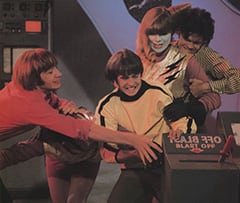
When John Lennon praised the Monkees and compared their wacky antics to the Marx Brothers, his compliment was not only flattering but ironic. It was the Beatles’ film, A Hard Day’s Night, after all, that provided the impetus for the television show, The Monkees. But the initial idea for a program based on a singing group actually preceded the show’s 1966 launch by a few years. If not for the Beatles, in fact, NBC-TV might very well have broadcast a show called The Folkees.
Bob Rafelson was an aspiring filmmaker in his 30s when he concocted an idea that would combine his two interests. Having directed television programs for ABC-TV and Desilu Productions, including a folk music program called Hootenanny, Rafelson had toyed for years with a concept that he thought would hook the youth market; a dramatic TV series based around a folk group. But the networks weren’t biting—yet.
In 1964, the Beatles struck. At the same time Rafelson teamed up with Bert Schneider, an executive at Screen Gems, and formed Raybert Productions. Immediately Rafelson told Schneider his idea, but now he had a new twist; he’d seen A Hard Day’s Night and learned that his ticket was neither folk music nor serious drama. A situation comedy about a fun-loving rock ’n’ roll group couldn’t lose. If teenagers would part with their allowance to see a movie, they’d surely sit in front of the television—and spend that allowance on pimple cream instead—to watch a funny rock ’n’ roll group.
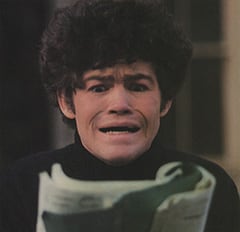
Step one was to sell the idea to adult TV executives who disdained the same youth market they hoped to reach, and thought the best way to reach them was via stupid exploitation flicks like beach party movies. They found an attentive ear in Jackie Cooper, the very same who’d been a Little Rascal once, and now spent his time as a senior executive at Screen Gems. Cooper went for it and placed the program with NBC. Now they only had to find their rock group.
Rafelson and Schneider opted against using an already established group (the Byrds and the Lovin’ Spoonful having briefly been considered) and against established actors. They decided to take out an ad.
Even the producers were shocked when no less than 437 hopefuls showed up to audition for the parts that called for “four insane boys, age 17–21” to become this new, put-together-from-scratch, Beatlesque rock group. But only in retrospect is it intriguing to think what might have happened if Rafelson and Schneider had chosen other potential actor/musicians on the line than they did. Imagine this: The Monkees, starring Stephen Stills, Paul Williams, Rodney Bingenheimer and—if persistent rumors are to be believed—Charles Manson!
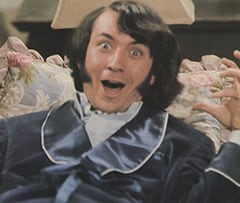
Of course, who they did choose was Davy Jones, an English actor and singer who was already signed to Screen Gems and had appeared with the Broadway cast of Oliver! on the same episode of the Ed Sullivan Show that introduced the Beatles; Michael Nesmith, a Texan folk singer who’d gone under the name Michael Blessing; Micky Dolenz, a child actor from L.A. who’d gone under the name Micky Braddock when he starred in the TV series, Circus Boy, and Peter Thorkelson, who shortened his name to Peter Tork whan [sic] he became a mild success on the Greenwich Village folk scene.
Ironically, of the four, Nesmith was the only one who actually came in response to the ad (Tork was recommended by his friend Steve Stills), and after the four were told they’d gotten the gig, there was a long spell in which they had almost nothing to say to one another. It appeared as if the Monkees—the name won out over the Creeps and the Turtles (the latter had recently been taken)—would be hired actors doing a job, until one day the foursome’s natural instinct for mischief took them over and they engaged in various incidents of mayhem that wouldn’t subside for the next three years.
It was a year between the September 1965 auditions and the show’s debut. In the meantime a cast of professionals had been hired to write and direct the show (including Paul Mazursky) and another team to come up with the music that this so-called band would lip sync to on the show. Contrary to popular belief, the Monkees were given the opportunity to perform their own music, but—despite some impressive efforts—it was agreed by all that the studio players had better provide the backing for the records; it was enough that these actors were being allowed to sing.

But what no one expected was that this bunch of actors would find success on the pop charts, let alone that their first single, “Last Train To Clarksville,” would be the number one hit in the country within weeks of the show’s debut.
So it was with greater hoopla than Rafelson and Schneider ever imagined that The Monkees was launched. The program was an immediate smash, Monkeemania a reality borne of hype and good timing. Pretty good for a show that was, if truth be told, basically quite dumb.
Not that that is necessarily a criticism. All of the best television comedy of the ’60s—Batman, Gilligan’s Island, Beverly Hillbillies, etc.—asked the viewer to suspend almost all hold on reality. The Monkees, like Batman or Laugh-In, say, relied on a heavy dose of camp and quick cuts to make it with this young generation who had the shortest attention span in history. Fact is, the show was almost cancelled before it ever aired; an early screening for kids found that they thought the show boring. Only when the pilot episode was reworked so that no scene lasted more than a few seconds and the plot was put through the shredder until there was nothing left of it, did The Monkees elicit howls from its audience. When it finally premiered on September 12, 1966, with an episode called “Royal Flush,” the concept had been teen-tailored so it couldn’t lose. And it didn’t.
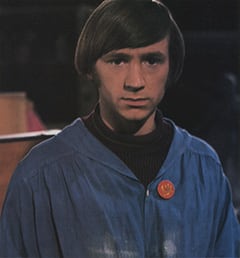
But what Screen Gems and Raybert didn’t expect was that they had created a monster comprised of four actor-singers plucked out of obscurity. Almost from the start, the Monkees began demanding more control over the shows, their image, the music. And bit by bit, they got it. The episodes retained their stupidity factor throughout the first season, but individual real-life Monkee personalities began invading their characters more and more. The boys especially doted on sending up the irony of their own existence, that of the program, and the Hollywood system itself. The Monkees constantly reminded the viewer that the group was indeed aware of the ludicrousness of their situation, and many a Monkee dialogue was infiltrated by a snide improvised aside putting the program or the group in its proper perspective.
And who could blame them? The Monkees knew that they were the brunt of criticism from all sides. They were, after all, not a real rock group but a created one, and in the ’60s—despite the fact that the Beatles, Stones and most other bands used session musicians and had crafty managers and agents—that did not rub with the “in” crowd. They were aware that the plots they were given—usually placing the boys in a surreal situation and Davy with a girl—were hokey. While the Beatles were courting the hip and progressing with their music, the Monkees were inventing bubblegum and providing scream fodder for pubescent girls. And so the group made the best of it by lampooning their predicament. The Monkees might have been inspired by A Hard Day’s Night, but the show was more like the Beatles’ cartoons. Something had to give.
By the time the second season rolled around in the fall of ’67, the Monkees wanted—and largely got—their way. They had already landed three consecutive number one albums, and proven with the third, Headquarters, that they could play their own music. Now they wanted the same chance on TV. The already-silly plots were put through the cuisinart and the Monkees insisted that their directors use every technological trick in the ’60s book. The producers were still nominally in charge of what went on, but they began to entrust the group with more creative control, realizing perhaps that these budding hippies had more to do with the show’s mega-success than any middle-aged scriptwriter or director. And so 1967–68 became the year of Monkees running amok.
Unheard-of lighting techniques were employed. Film was run backwards, slow-mo and every which way. Snippets from news programs were thrown in for the hell of it, and social commentary was injected into the dialogue. The group was allowed to dress as it wished, trading in matching Beatle-style duds for paisley and beads, and they brought in their own hip props and guest stars. Folk singer Tim Buckley ended the last-ever Monkees episode with one of his sensitive ballads, and then-hot comics like Pat Paulsen and Ruth Buzzi also made appearances.
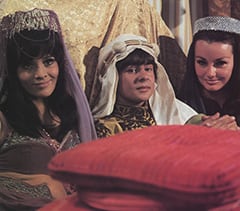
One of the most bizarre episodes had to be the second-to-last, “Monkees Blow Their Minds,” which aired in March ’68. Frank Zappa, still unknown outside of the ultra-hip underground rock circuit, appeared loosely disguised as Mike Nesmith (he wore a wool hat) while Nesmith “became” Frank Zappa (his nose kept falling off). For a few minutes, the two bandied about casual chit-chat before fake Frank—to the strains of the Mothers’ “Mother People”—“conducted” fake Mike “playing” a car, that is to say, smashing it with a sledgehammer.
Scenarios like the above should have been adequate preparation for what was to come in the Monkees’ full-length feature film, Head, which began filming in February 1968. But the film ultimately outdid anything ever seen on the TV show for outright weirdness. Almost inperceptible [sic] and psychedelic, Head was the ultimate exercise in Monkee self-degradation, a non-stop put-down of the plasticity that engulfed and dictated the Monkees phenomenon.
But what a relic it is! Rafelson and Schneider brought in a young writer named Jack Nicholson to work on the project with them. Between them. Rafelson, Nicholson and the Monkees concocted a free-form period piece that both honored the silver screen’s great moments—it was a western, a spy flick, a slapstick comedy, and a war drama (with heavy anti-war undertones)—and ruthlessly picked apart the Monkees’ success and their manipulation as Hollywood puppets. The film stiffed at the box office, but today (available on videotape) it is seen by many as one of the great underrated hippie-era classics. Guest shots by Zappa, Annette Funicello, Sonny Liston, Terri Garr and others don’t hurt its camp value
Looking at Head today, though, it is obvious why the Monkees could not go back to make a third season of television comedies. As individuals and as artists they had progressed—much like the Beatles—beyond the teenybopper idolatry that had made them successful. So the Monkees were not overly upset when NBC, after 58 shows, cancelled the program after the second series wound up in early ’68. The four made a final television special entitled 33 ⅓ Revolutions Per Monkee later that year. Directed by Jack Good and featuring the Buddy Miles Express, Julie Driscoll, Brian Auger & Trinity, Jerry Lee Lewis, Little Richard and Fats Domino, NBC ran it opposite the Oscars on April 14, 1969. It failed miserably in the ratings. Peter Tork subsequently became the first to leave the group (which continued as a musical outfit). followed soon by Nesmith. By 1970, the Monkees were through, having been—as the Pre-fab Four—America’s biggest rock group and a revolutionary TV team.
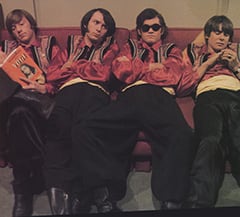
Of course, it is now well known what has happened since. After languishing for 15 years, during which the scorn directed at the group and the show rarely subsided, the Monkees were revived last year. MTV started the ball rolling by rerunning 45 original episodes in one marathon “Pleasant Valley Sunday,” then airing the show twice daily for another month. A new generation discovered the Monkees—preserved without wrinkles—while three-quarters of the original group, now in their 40s, staged a hugely successful reunion tour. And now there’s talk of a new film project. Head II? Don’t bet on it.
Also in the near future is the new Monkees, four bright-eyed youngsters resembling A-Ha whose new TV series is set to premiere in September. Firmly condemned by the real Monkees, the new program is the brainlesschild of some of the people involved with the original show, who held auditions—sound familiar?—to pick their cast.
Among those who didn’t get picked for this second string? Jason Nesmith, whose dad was the lone holdout in the reunion of the originals last year. We suggest a serious father-son talk here. After all, look what happened to Charlie Manson when he didn’t become a Monkee.




